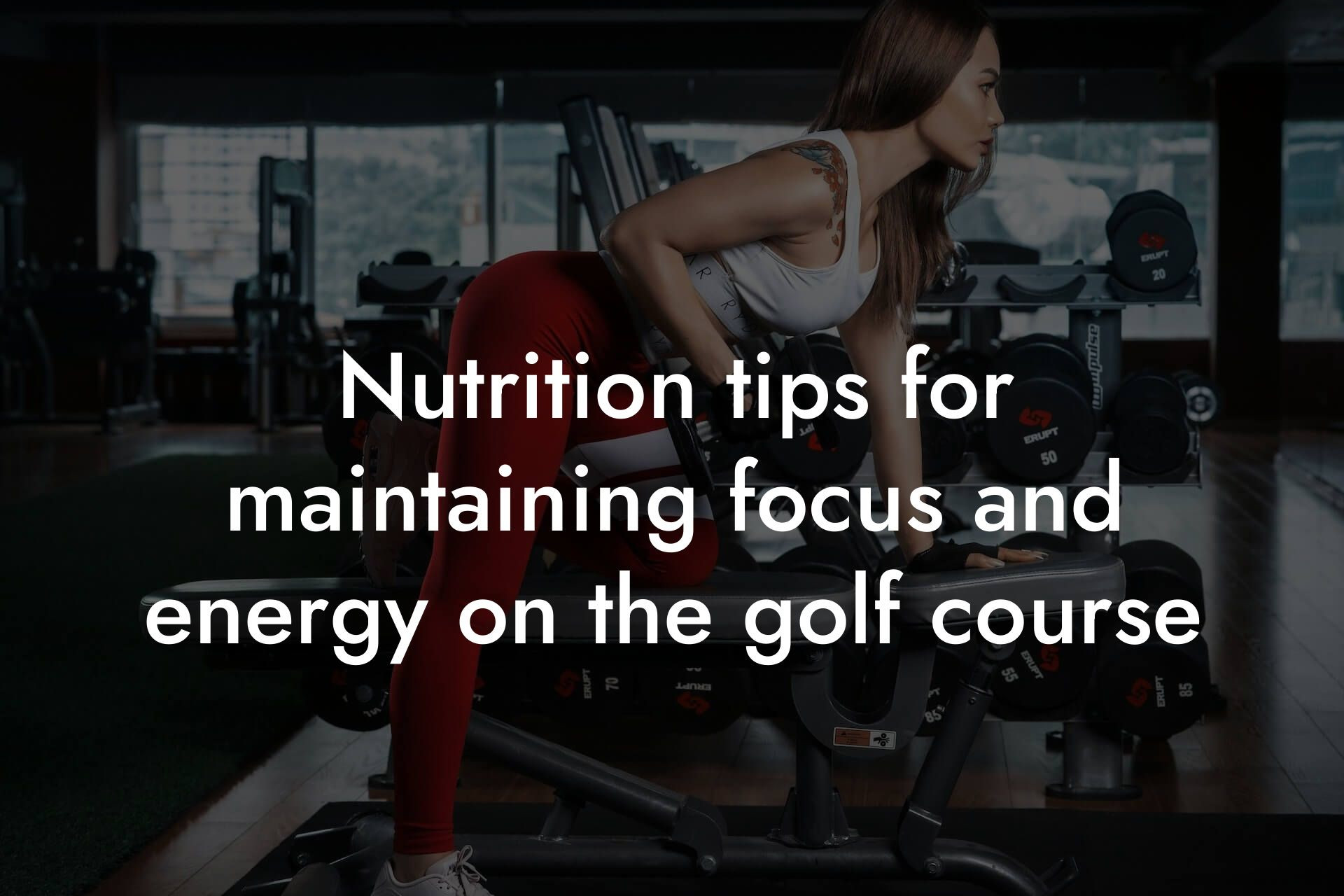As a golfer, you understand the importance of precision, control, and power in your game. What you may not realize is that your body fat percentage plays a significant role in your overall performance on the course. Excess body fat can hinder your flexibility, balance, and coordination, ultimately affecting your score. In this article, we'll delve into the importance of managing body fat for optimal golf performance and provide you with actionable tips to achieve your goals.
Table of Contents
The Impact of Body Fat on Golf Performance
Carrying excess body fat can have a profound impact on your golf game. Here are just a few ways it can affect your performance:
• Reduced flexibility: Excess body fat can limit your range of motion, making it more difficult to maintain a consistent swing and generate power.
• Decreased balance and coordination: Extra weight can throw off your balance and coordination, leading to inconsistent shots and poor overall performance.
• Increased risk of injury: Carrying excess body fat can put additional stress on your joints, increasing your risk of injury and sidelining you from the game.
• Decreased endurance: Excess body fat can make it more difficult to maintain your energy levels throughout a round, leading to fatigue and decreased performance.
What is a Healthy Body Fat Percentage for Golfers?
So, what is a healthy body fat percentage for golfers? The answer varies depending on age, sex, and other factors, but here are some general guidelines:
• For men: 10-15% body fat is considered ideal for golfers, as it allows for a balance of strength, power, and flexibility.
• For women: 16-20% body fat is considered ideal, as it allows for a balance of strength, power, and flexibility.
Keep in mind that these are general guidelines, and your ideal body fat percentage may vary depending on your individual needs and goals.
How to Measure Body Fat Percentage
So, how do you measure your body fat percentage? There are several methods, including:
• Dual-Energy X-ray Absorptiometry (DEXA): This is a highly accurate method that uses X-rays to measure bone density and body composition.
• Hydrostatic Weighing: This method involves measuring your weight underwater to determine your body density and fat percentage.
• Skinfold Measurements: This method involves measuring the thickness of your skin folds at specific points on your body to estimate your body fat percentage.
At Tano Performance Group, we use DEXA scanning to provide our clients with a comprehensive body assessment and accurate body fat percentage measurements.
Nutrition Strategies for Managing Body Fat
When it comes to managing body fat, nutrition plays a critical role. Here are some strategies to help you achieve your goals:
• Eat a balanced diet: Focus on whole, nutrient-dense foods like lean proteins, complex carbohydrates, and healthy fats.
• Keep track of your macronutrient intake: Make sure you're consuming the right amount of protein, carbohydrates, and fat to support your goals.
• Hydrate adequately: Drinking plenty of water can help with weight loss and overall health.
• Avoid processed foods: Processed foods are often high in unhealthy fats, added sugars, and sodium, making them a hindrance to your goals.
Exercise Strategies for Managing Body Fat
In addition to nutrition, exercise plays a critical role in managing body fat. Here are some strategies to help you achieve your goals:
• Incorporate strength training: Building lean muscle mass can help you burn more calories at rest, making it easier to manage your body fat percentage.
• Incorporate high-intensity interval training (HIIT): HIIT involves short bursts of intense exercise followed by brief periods of rest. This type of exercise has been shown to be effective for weight loss and improving body composition.
• Incorporate flexibility and mobility exercises: Maintaining flexibility and mobility is critical for golfers, as it can help improve your range of motion and reduce your risk of injury.
Additional Tips for Managing Body Fat
In addition to nutrition and exercise, here are some additional tips to help you manage your body fat:
• Get enough sleep: Poor sleep can disrupt your hormones, leading to increased body fat storage.
• Manage stress: Chronic stress can lead to increased cortisol production, which can contribute to belly fat storage.
• Monitor your progress: Regularly tracking your body fat percentage and progress can help you stay motivated and on track.
Managing body fat is critical for optimal golf performance. By understanding the importance of body fat management, measuring your body fat percentage, and implementing nutrition and exercise strategies, you can take your game to the next level. Remember to stay consistent, patient, and persistent, and don't be afraid to seek the help of a professional if you need guidance. At Tano Performance Group, we're dedicated to helping high-earning professionals like you achieve their goals and take their game to the next level.
Frequently Asked Questions
What is the ideal body fat percentage for golfers?
For male golfers, the ideal body fat percentage is between 6-13%, while for female golfers, it's between 16-23%. This range allows for optimal muscle mass, strength, and power while minimizing excess fat that can hinder performance.
How does body fat affect my golf swing?
Excess body fat can affect your golf swing by reducing flexibility, balance, and coordination. It can also increase your risk of injury, particularly in the back and joints. Maintaining a healthy body fat percentage can help improve your overall swing mechanics and reduce your risk of injury.
What are the benefits of managing body fat for golf performance?
Managing body fat can improve your golf performance by increasing power, speed, and distance. It can also enhance your overall fitness, reduce your risk of injury, and boost your confidence on the course.
How can I measure my body fat percentage?
There are several ways to measure body fat percentage, including dual-energy X-ray absorptiometry (DXA), hydrostatic weighing, and skinfold measurements. You can also use a body fat caliper to estimate your body fat percentage.
What is the difference between visceral fat and subcutaneous fat?
Visceral fat is the fat that surrounds your organs in the abdominal cavity, while subcutaneous fat is the fat that lies just beneath the skin. Visceral fat is a greater health risk, as it's associated with an increased risk of chronic diseases like diabetes and heart disease.
How does diet affect body fat percentage?
Diet plays a critical role in managing body fat percentage. A diet high in processed foods, sugar, and saturated fats can contribute to excess body fat, while a diet rich in whole foods, lean proteins, and healthy fats can help promote weight loss and improve body composition.
What are the best foods for golfers looking to manage body fat?
Foods that are rich in protein, fiber, and healthy fats, such as lean meats, fish, fruits, vegetables, and nuts, can help support weight loss and improve body composition. Golfers should also focus on whole, unprocessed foods and limit their intake of sugary drinks and snacks.
How can I incorporate strength training into my golf fitness routine?
Incorporating strength training into your golf fitness routine can help improve your power, speed, and distance. Focus on exercises that target your core, legs, and glutes, such as squats, lunges, and deadlifts.
What are the benefits of high-intensity interval training (HIIT) for golfers?
HIIT can help improve cardiovascular fitness, increase speed and power, and enhance overall fitness. It can also be an effective way to burn fat and improve body composition.
How can I stay hydrated during a round of golf?
Staying hydrated is critical for optimal golf performance. Aim to drink at least 8-10 glasses of water per day, and consider bringing a water bottle with you on the course. Avoid sugary drinks and caffeine, which can dehydrate you further.
What are the benefits of flexibility and mobility exercises for golfers?
Flexibility and mobility exercises can help improve your range of motion, reduce your risk of injury, and enhance your overall golf performance. Focus on exercises that target your shoulders, hips, and lower back.
How can I reduce my body fat percentage safely and effectively?
To reduce your body fat percentage safely and effectively, focus on making sustainable lifestyle changes, such as eating a healthy diet, incorporating regular exercise, and getting enough sleep. Avoid fad diets and quick fixes, which can be harmful to your health.
What is the role of sleep in managing body fat percentage?
Sleep plays a critical role in managing body fat percentage. Aim for 7-9 hours of sleep per night to help regulate your hormones, support weight loss, and improve overall health.
How can I track my progress and stay motivated?
Tracking your progress and staying motivated is critical for achieving your fitness goals. Consider working with a personal trainer or fitness coach, and use tools like progress photos, measurements, and body fat percentage to track your progress.
What are the benefits of working with a personal trainer or fitness coach?
Working with a personal trainer or fitness coach can help you develop a customized fitness plan, stay motivated, and achieve your fitness goals. They can also provide guidance on proper form and technique, reducing your risk of injury.
How can I incorporate stretching and foam rolling into my golf fitness routine?
Incorporating stretching and foam rolling into your golf fitness routine can help improve your flexibility, reduce your risk of injury, and enhance your overall golf performance. Focus on exercises that target your shoulders, hips, and lower back.
What are the benefits of yoga and Pilates for golfers?
Yoga and Pilates can help improve your flexibility, balance, and core strength, all of which are critical for optimal golf performance. They can also reduce your risk of injury and enhance your overall fitness.
How can I stay motivated and avoid burnout?
To stay motivated and avoid burnout, focus on setting realistic goals, celebrating your progress, and taking rest days as needed. It's also important to find a workout buddy or accountability partner to help keep you motivated.
What are the benefits of tracking my macronutrient intake?
Tracking your macronutrient intake can help you optimize your diet for weight loss and improve body composition. It can also help you identify areas for improvement and make sustainable lifestyle changes.
How can I incorporate cardio exercises into my golf fitness routine?
Incorporating cardio exercises into your golf fitness routine can help improve your cardiovascular fitness, increase your endurance, and enhance your overall golf performance. Focus on exercises like jogging, cycling, and swimming.
What are the benefits of working on my mental game?
Working on your mental game can help you build confidence, reduce stress and anxiety, and improve your overall golf performance. Focus on techniques like visualization, positive self-talk, and mindfulness meditation.
How can I balance my fitness goals with my busy schedule?
To balance your fitness goals with your busy schedule, focus on finding exercises that can be done in short periods of time, such as HIIT workouts or bodyweight exercises. You can also consider working with a personal trainer or fitness coach to develop a customized fitness plan.
What are the benefits of incorporating technology into my fitness routine?
Incorporating technology into your fitness routine can help you track your progress, stay motivated, and optimize your workouts. Consider using fitness trackers, mobile apps, and other tools to support your fitness goals.
How can I make sustainable lifestyle changes?
To make sustainable lifestyle changes, focus on making small, incremental changes that you can maintain over time. Avoid fad diets and quick fixes, and instead focus on developing healthy habits that you can incorporate into your daily routine.
Here are some related articles you might love...
- Strength training to improve golf performance
- Nutrition tips for maintaining focus and energy on the golf course
- The impact of body composition on golf swing power and accuracy
- The role of core strength in golf accuracy
- Bone density and injury prevention in golf
- Recovery strategies for golfers after a tournament
- Off-season fitness programs for golfers
- How DEXA scans can benefit professional golfers
- Maintaining flexibility and muscle mass for a better golf swing
Zak Faulkner
Zak Faulkner is a leading authority in the realm of physical health and body composition analysis, with over 15 years of experience helping professionals optimise their fitness and well-being. As one the experts behind Tano Performance Group, Zak has dedicated his career to providing in-depth, science-backed insights that empower clients to elevate their physical performance and overall health.
With extensive knowledge of DEXA technology, Zak specializes in delivering comprehensive body assessments that offer precise data on body fat, muscle mass, bone density, and overall physique. His expertise enables individuals to make informed decisions and achieve their fitness goals with accuracy and confidence. Zak’s approach is rooted in a deep understanding of human physiology, combined with a passion for helping clients unlock their full potential through personalised strategies.
Over the years, Zak has earned a reputation for his commitment to excellence, precision, and client-focused service. His guidance is trusted by top professionals who demand the best when it comes to their health. Whether advising on fitness programs, nutritional strategies, or long-term wellness plans, Zak Faulkner’s insights are a valuable resource for anyone serious about taking their health and fitness to the next level.
At Tano Performance Group, Zak continues to lead our Content Team revolutionising how professionals approach their physical health, offering unparalleled expertise that drives real results.




